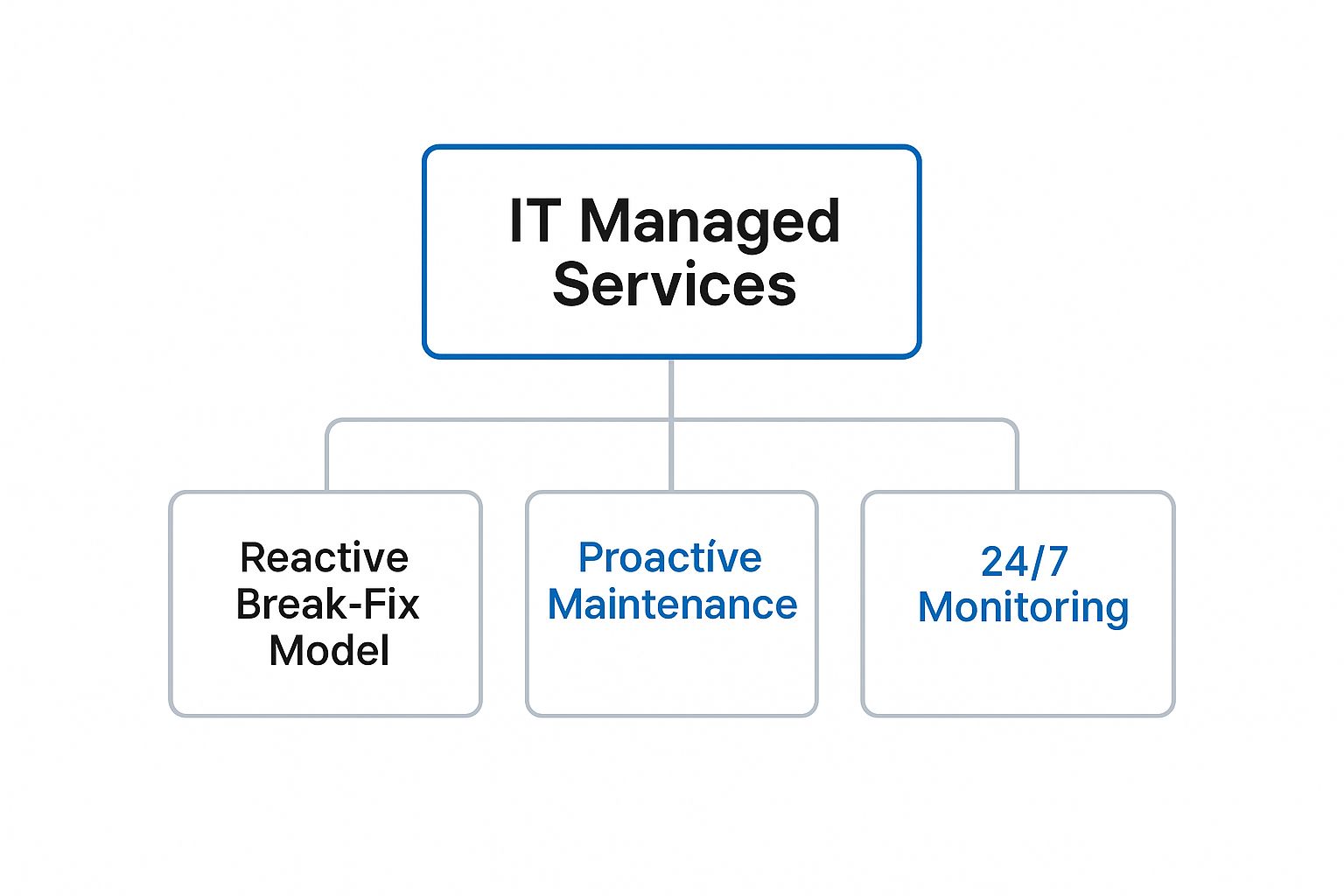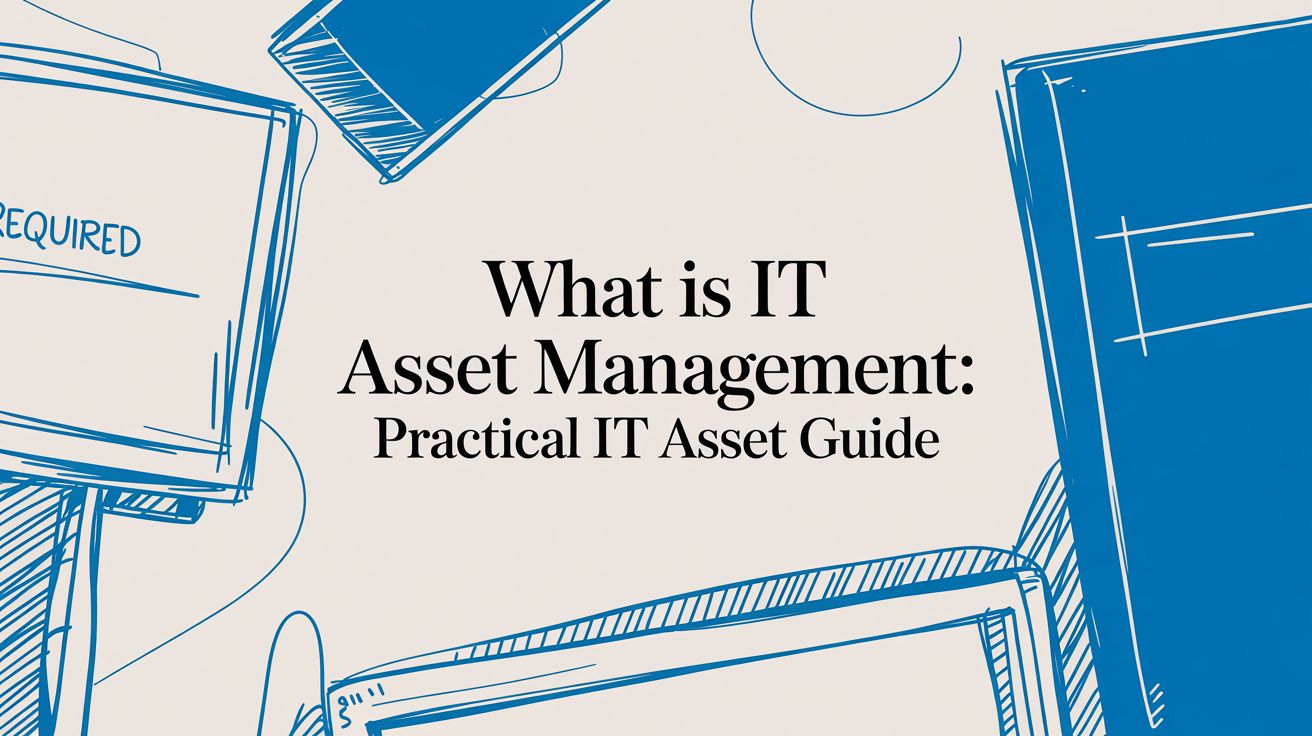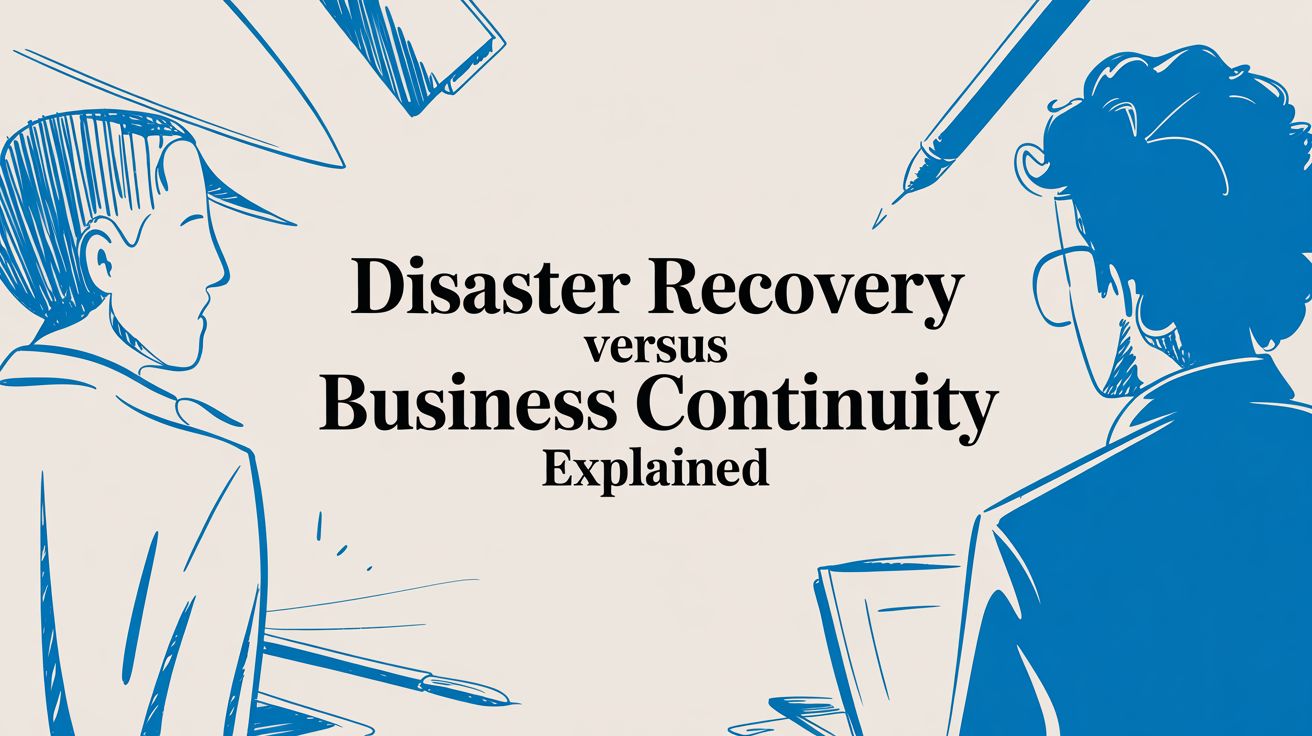IT Managed Services for Business Growth
Think of IT managed services as having a dedicated, outsourced technology department for your business. Instead of waiting for something to break, a Managed Services Provider (MSP) proactively monitors, maintains, and secures your systems 24/7. This approach is all about preventing problems before they can cause costly downtime, letting your team stay focused on what they do best.
Your Expert Pit Crew for Business Technology
Imagine your business is a high-performance race car. Sure, you could try to be the driver and the mechanic, but every minute you spend under the hood is a minute you aren't winning the race. An IT managed services provider, or MSP, acts as your expert pit crew. They work around the clock to tune your engine, check your systems, and fix potential issues before they cause a breakdown on the track.
This is a massive shift from the old, reactive "break-fix" way of doing things. That’s when you only call for help after a server has already crashed or a network outage has brought your entire operation to a standstill. For a business owner in Dallas or Memphis, that model is unpredictable, surprisingly expensive, and incredibly stressful.
The modern approach is proactive. It’s about preventing downtime, beefing up security, and turning your technology from a constant headache into a real strategic asset. When you partner with an MSP, you get an entire team of specialists for less than the cost of hiring a single senior IT person.
From Reactive to Proactive IT Support
Deciding between hiring an internal team and partnering with an MSP is a common crossroads for many small and mid-sized businesses. Each path has its own set of trade-offs when it comes to cost, expertise, and how you approach IT management.
Here's a straightforward breakdown to help you see the difference:
Comparing In-House IT vs IT Managed Services
Ultimately, the choice comes down to strategy. An in-house team offers a dedicated, on-site presence, but an MSP provides a broader, more flexible, and often more cost-effective solution focused on preventing problems in the first place.
This graphic really drives home the core difference between the old break-fix model and the proactive strategy of modern IT managed services.

The real takeaway here is the move from just reacting to problems to actively stopping them. A huge piece of this involves solid cloud infrastructure management services, which make sure your digital foundation is both stable and running at peak performance.
The demand for this proactive approach is skyrocketing. The global managed services market is expected to hit an incredible USD 1,314.9 billion by 2035, which is a clear signal that businesses are choosing strategic IT partnerships over reactive fixes. These partnerships often go beyond basic support to include a whole suite of professional IT services designed to help businesses grow without the usual tech headaches. For business owners in places like Dallas, TX, and Memphis, TN, having a local partner can turn technology into a reliable engine for growth.
The Core Pillars of Managed IT Support

A great partnership with a managed services provider (MSP) rests on a few fundamental pillars. Think of these as the specialized departments of your new, outsourced tech team. Each one handles a critical area, and they all work in concert to keep your business running smoothly, securely, and ready for whatever comes next.
These pillars aren't just high-level ideas; they're the real-world services that solve the tech headaches businesses face every day. Whether it's locking down employee laptops or making sure you can bounce back after a server crash, each service is built to deliver real, measurable results.
Infrastructure and Cloud Management
The bedrock of your company's technology is its infrastructure. This includes your servers, any cloud services you use, and the core applications that your business depends on. This pillar is all about making sure that foundation is rock-solid, secure, and running as efficiently as possible.
Practical Example: We recently worked with a growing Dallas-based accounting firm stuck with an old, on-premise server that was slow and expensive to maintain. We managed their migration to a Microsoft 365 and Azure hybrid environment. The switch was seamless—zero downtime—and their team suddenly had secure access to everything they needed, from anywhere. Plus, they ditched the high capital costs of managing old hardware. That’s what expert infrastructure management looks like.
Proactive Network Support
Your network is the central nervous system of your business. If it goes down, work grinds to a halt. Proactive network support is designed to prevent that from ever happening in the first place.
An MSP acts like a full-time digital security guard for your network, constantly monitoring for slow-downs, suspicious activity, or hardware that's about to fail. This isn't just about fixing problems; it's about spotting them before they impact your productivity.
Client Scenario: A logistics company in Memphis relies on constant connectivity to track its fleet. A network outage during peak hours would be a disaster. Their MSP’s monitoring tools spotted a failing network switch and their team replaced it overnight. This small, proactive fix completely avoided an outage that would have cost the company thousands in lost revenue and delays, ensuring business uptime.
Endpoint and Security Management
Every single device connected to your network—from laptops and desktops to smartphones—is called an "endpoint." And every single one is a potential doorway for a cyberattack. A huge part of solid managed IT support involves setting up and managing effective Information Security Management Systems.
This pillar covers several key functions:
- Patch Management: Keeping all software updated with the latest security fixes as soon as they’re released. For example, when a critical vulnerability is announced for Windows or Adobe, we can deploy the patch to all devices within hours, not days.
- Advanced Antivirus & Endpoint Detection and Response (EDR): Deploying and managing top-tier security software that can stop malware and ransomware in its tracks. Unlike old antivirus, modern EDR can even roll back a machine to its pre-attack state.
- Device Security: Configuring all company devices to meet strict security policies, which protects your data even if a laptop is lost or stolen.
Locking down these endpoints is non-negotiable for a modern defense strategy. If you want to dive deeper, you can check out our complete guide to IT security to see how all these layers work together to protect a business.
Business Continuity and Disaster Recovery
So, what’s the plan when things go wrong? A freak storm could knock out power in your Dallas office, or a server could suddenly die. Business continuity is the playbook that ensures you can keep the lights on, no matter what happens.
This always includes reliable, tested data backups and a clear disaster recovery strategy. For one of our healthcare clients, it meant having a system that restored critical patient data from a backup in under 15 minutes after a server malfunction. Patient care was never compromised. That’s the goal: turning a potential catastrophe into a minor hiccup.
How Managed Services Drive Business Growth
Let's be honest, good IT isn't just about making sure computers turn on. It's about creating real opportunities for your business to succeed. When you find the right managed services partner, you stop seeing technology as just another expense and start seeing it for what it truly is: a powerful engine for productivity, security, and growth.
This shift happens when you connect the dots between technical tasks and tangible business results. For instance, proactive network monitoring isn't just some techy jargon—it's what prevents your entire team from losing an afternoon of work because of an outage that could have been avoided. In the same way, managed cybersecurity isn't about fancy software; it's about safeguarding your brand's reputation and keeping your customers' trust intact.
This strategic perspective completely changes how you think about your technology budget.
From Unpredictable Expenses to Budget Certainty
The old break-fix IT model is a financial rollercoaster. One month, your IT costs are zero. The next, you're hit with a five-figure emergency invoice to replace a failed server. That kind of wild unpredictability makes it impossible to plan ahead.
IT managed services swap that chaos for a simple, flat monthly fee. This gives you absolute budget certainty, freeing you up to invest in growth instead of just bracing for the next IT disaster. Your technology spending transforms from a reactive, unpredictable cost into a fixed, strategic investment.
One of the biggest wins with this model is getting access to a whole team of specialists—cloud architects, cybersecurity pros, network engineers—that would be incredibly expensive for most small or mid-sized businesses to hire on their own. You get the collective brainpower of an entire IT department for a fraction of the cost.
A Real-World Growth Story
Picture a professional services firm in Dallas that started out with just 10 employees. They knew they were growing, but hiring a full-time IT person was a huge expense, and one person couldn't possibly have all the skills they'd eventually need. So, they decided to partner with a managed services provider (MSP).
That partnership allowed them to scale all the way to 50 employees without ever hiring a single internal IT person. Here’s what that looked like in practice:
- Seamless Onboarding: When a new employee joined, their laptop was already configured, secured, and ready to go on day one. No downtime, just immediate productivity.
- Scalable Cloud Solutions: Their MSP managed their entire Microsoft 365 environment, which meant adding new users was as simple as sending an email, and everyone always had secure access to company files.
- Proactive Security: As the firm grew, so did its risk of cyberattacks. The MSP scaled their security defenses right alongside them, protecting the company from new threats without the firm's leaders having to do a thing.
This firm’s story shows how the right managed services partner is a catalyst for growth, not a drain on resources. The growing complexity of technology is exactly why the managed services market is booming, as more companies look for smart, affordable ways to outsource their IT. You can learn more about how IT support helps small and medium-sized businesses in Dallas thrive. For businesses in Dallas and Memphis, this kind of strategic support is the secret to turning technology into a genuine competitive edge.
Decoding IT Managed Services Pricing Models

Before you can partner with a Managed Service Provider (MSP), you need to get a handle on how they charge. Understanding their pricing is the key to making a confident decision, ensuring you're only paying for what you actually need while keeping your budget predictable. Let's break down the most common ways MSPs structure their fees.
Every model is built for a different kind of business. For example, a law firm in Dallas where every paralegal has their own dedicated computer has very different needs than a manufacturing plant in Memphis with shared computer terminals on the factory floor. The right pricing plan reflects how your company actually works.
Common Pricing Structures Explained
You'll almost always run into one of three models: per-device, per-user, or an all-inclusive flat-fee. The best choice really boils down to your company's structure and what you hope to get out of your IT partnership.
The per-device model is exactly what it sounds like. You pay a set price for every single piece of equipment being managed—each server, computer, and network switch. This works beautifully for businesses that have a stable, predictable number of physical devices.
On the other hand, the per-user model is becoming more and more common. Instead of billing by device, the MSP charges a flat fee for each employee they support. This makes a lot of sense today, when a single person might use a desktop at the office, a laptop on the road, and a smartphone to check email.
The third option, an all-inclusive flat-fee model, wraps your entire IT environment into one fixed monthly cost. This is the ultimate choice for budget certainty, as it covers all of your support, monitoring, and security services without any unexpected bills.
To help you visualize how these models differ, let's put them side-by-side.
IT Managed Services Pricing Models at a Glance
This table gives you a simple breakdown of the common pricing structures you'll encounter, helping you figure out which one aligns with your business goals.
As you can see, each model has its place. Choosing the right one is a huge step toward building a successful partnership, as it makes sure your IT spending is perfectly aligned with your operational reality.
To get a feel for how these models look in the real world, you can explore our straightforward approach to IT services pricing and find a plan that makes sense for your bottom line.
The Future of IT Support with AI and Automation

A good managed service provider doesn't just keep your IT running today; they're already thinking about what your business will need tomorrow. This is where Artificial Intelligence (AI) and automation come in, completely changing the game for IT managed services. We're moving beyond just being proactive and into the realm of being predictive.
This isn't some far-off concept—it’s happening right now. Smart technology is leading to faster support, tighter security, and systems you can truly count on. Think about an IT setup that doesn't just fix problems as they pop up but actually sees them coming. That's the new standard.
From Proactive to Predictive Support
Modern MSPs are deploying AI-driven tools that can spot a potential hardware failure long before it brings your business to a halt. For instance, an AI watching your server could notice tiny drops in performance that signal a hard drive is on its last legs. Instead of a middle-of-the-night crash and emergency repairs, the drive gets replaced during scheduled maintenance. No drama, no downtime.
Automation, meanwhile, takes care of the repetitive but crucial tasks with flawless precision.
- Automated Patching: Security patches and software updates get rolled out to every device automatically, the minute they're available. This closes security holes before you even knew they existed, all without a technician lifting a finger.
- Intelligent Threat Detection: Advanced security platforms learn the normal rhythm of your network. If something out of the ordinary happens—like a user account trying to access sensitive files at 3 AM—the system can flag it as a potential threat much faster than a human ever could.
The Growing Role of Smart Technology
This move toward intelligent systems is pushing the entire managed services industry forward. The best providers are already using AI to deliver smarter data analytics and more robust security. It's how they help businesses get in front of complex threats and operational hiccups. If you're curious about the scale of this shift, you can read more about how AI is redefining the managed services market.
The end goal is an IT environment that’s almost self-sufficient. This frees up the human experts to work on the big-picture stuff that actually helps your business grow. For owners in Dallas and Memphis, it simply means your technology works better and more reliably.
When you team up with an MSP that has embraced these tools, you're not just fixing today's problems—you're getting your business ready for the future. To keep up with what's next, it's always a good idea to follow the latest IT trends.
How to Choose the Right MSP Partner for Your Business
Picking an IT managed services provider is a big deal. It’s less like buying a new piece of software and more like hiring a new executive for your team. The right partner will feel like an extension of your own company, actively helping you grow. The wrong one? Well, that just leads to endless headaches and frustration.
To find the perfect fit, you have to look past the monthly fee and really dig into what makes a provider tick. This all starts with asking the right questions.
Digging Deeper Than the Sales Pitch
Don't just ask what they do; ask who they've done it for. Have they worked with other businesses in your industry, whether it's a dental practice or a law firm? An MSP that already gets the unique compliance rules and daily operational hiccups you deal with is going to be infinitely more valuable right out of the gate.
A provider’s promises are only as good as their ability to back them up. That’s where the Service Level Agreement (SLA) comes into play. This isn't just a document; it's their formal commitment to you, spelling out exactly how quickly they'll respond and fix problems. Always ask to see it.
A vague promise of "we offer fast support" just won't cut it. You need hard numbers. If your main server goes down, are they contractually obligated to respond in 15 minutes or two hours? Getting this in writing protects your business and sets clear, measurable expectations.
And don't just take their word for it. Ask for testimonials or case studies from current clients, especially other businesses in the Dallas or Memphis area. Hearing directly from a local company about their real-world experience gives you a much better sense of the provider's reliability than any sales brochure ever could.
Why a Local Team Makes a Difference
Sure, most IT issues today can be handled remotely. But what about the ones that can't? When a server physically crashes or a network outage takes your whole office offline, you need someone on-site—fast.
Choosing an MSP with a strong presence in Dallas, TX, or Memphis, TN, means you have a team that can physically show up when a real emergency hits. This local connection also means they understand the regional business environment, which often translates into more relevant and personalized advice for your company.
Ultimately, you're looking for more than just a tech vendor. You're searching for a true technology partner who gets your business goals and fits with your company culture. By focusing on these critical questions and valuing both technical skill and local presence, you can find an MSP that will help you cut downtime, get a handle on costs, and confidently move your business forward.
Common Questions We Hear About IT Managed Services
Making the switch to managed services is a big step, so it's natural to have questions. We get it. Let's walk through some of the most common concerns business owners have when they're thinking about bringing on an IT partner.
What Size Business Gets the Most Out of This?
Honestly, companies of all sizes can benefit, but small and mid-sized businesses (SMBs) often feel the biggest, most immediate impact. It's tough for an SMB to justify the cost of an in-house team with specialists in cybersecurity, cloud infrastructure, and network engineering. That's a huge payroll.
An MSP gives you instant access to that entire bench of enterprise-level talent and their toolsets, all for a predictable monthly fee. It’s a way for small businesses in Dallas and Memphis to level the playing field and compete with larger corporations.
Am I Going to Lose Control of My IT?
Not at all. In fact, a good MSP partnership actually gives you more control by giving you better visibility and a clear strategic roadmap.
You get to step away from the day-to-day firefighting—the password resets, the server patches, the network glitches—and focus on the big picture. You're no longer stuck in the weeds. Your provider handles the tactical work, but you always steer the ship, deciding how technology will drive your business forward.
Think of your MSP as a high-level technology advisor and an extension of your own team. They manage the "how" so you can stay focused on the "why."
Is This Really Cheaper Than Hiring an In-House Team?
When you look at the total cost, it's almost always more cost-effective. The salary for just one senior IT professional is only the beginning. You also have to factor in benefits, vacation time, sick days, ongoing training, and all the expensive software and hardware they need to do their job effectively.
With IT managed services, you get a whole team of specialists for a single, fixed fee. That fee is often less than the fully-loaded cost of a single full-time hire, eliminating surprise expenses while delivering a much wider range of expertise.
Ready to turn your technology into a reliable asset instead of a constant headache? PWR Technologies LLC offers proactive IT support for businesses across Dallas, TX, and Memphis, TN, with a 99% problem prevention rate. Get the peace of mind that comes with expert management and a team that answers in under three minutes.
Learn how we can support your growth at https://www.pwrtechnologies.com.
Article created using Outrank




